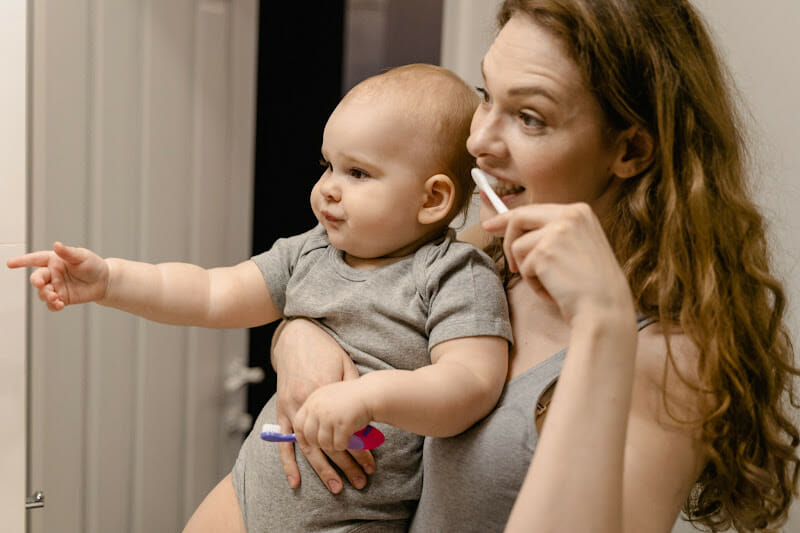1. What is a baby’s first tooth and what does it mean
A natal tooth refers to a tooth coming in without having descended from the gums. By 6 months of age, most children have one natal tooth visible in the back of their mouths. They are generally much smaller than adult teeth , but still can be a cause for concern if they are loose enough to wiggle around in the mouth.
2. Baby’s first tooth timeline
By 8 months, most children have two natal teeth coming through the gums and by 12 months there should be four . Between 18-24 months, another 4-6 teeth should push through. These last six will start falling out around age 2 or 3 when the permanent ones come in. The entire sequence of events usually only takes about three years before a complete eruption is finished (though some kids might get all their permanent teeth as early as age 3, while others don’t show their last molars until after age 5).
3. When should I take my child to the dentist for their first visit
Anytime a baby’s teeth start coming in is a good time to make an appointment. By scheduling a checkup around 8 months of age, you can be sure that they will have at least two natal teeth so your pediatric dentist can get a good look and feel of them without too much difficulty. They can diagnose whether or not they are loose or causing any pain and also give advice on the best way to handle teething symptoms such as fever , diarrhea , and trouble sleeping . Even if all seems well with your little one, it doesn’t hurt to get them accustomed to the dentist’s office early on.
4. How do I care for my child’s teeth as they grow up
-Begin cleaning around age 1 -One of the best ways to help prevent cavities is making sure children are brushing their teeth at least twice a day, especially before bedtime . Brushing typically takes about two minutes and it only takes this short amount of time for most kids (if not supervised) to swallow toothpaste or make a small mess with it. The American Dental Association recommends using water as a gentle way to give your child a thorough rinse after brushing their teeth, but avoid giving too much as this could lead to other problems such as intoxication from drinking so much water at once.
-To prevent bottles or other items from being given before bedtime that might stain the teeth , use an appropriate sized nipple for your child to drink out of and avoid putting any type of sugar in their bottle, which can lead to cavities later on . Teachers are also encouraged not to give candy to children who may have loose natal teeth as this increases the chances of tooth decay .
-It’s important to make sure kids get enough calcium in their diet, which helps keep the enamel solid. This usually results in stronger teeth for them for life. While high amounts of fluoride can be toxic , it is still recommended by dentists that children get a small amount through tap water or brushing twice per day with a fluoridated toothpaste.
5. How to know when your child’s teeth are coming in
A lot of children have problems with teething , which can lead to fevers, diarrhea , and an upset stomach . The most common symptom is increased drooling as saliva production increases as a result of the gums being swollen from the new tooth pushing through. In addition, the tooth may feel more sensitive than usual, so there could also be signs of pain or difficulty chewing on that side of his or her mouth. That being said, it is sometimes difficult for parents to determine if baby teeth are loose enough to come out on their own or if they need outside assistance due to how short they tend to be (usually less than a half inch long).
6. How to take care of a loose baby tooth
If your child loses a tooth before it has fully come in , there are two ways you can address the situation . The first, and most recommended way is to have them put under local anesthesia so that they may wiggle it back and forth until it comes out on its own after which point you should clean the space with a damp cloth to get rid of any debris from the loose natal tooth. This option can be costly however as many insurance companies do not cover the procedure, which leads some parents to instead try putting their children under general anesthesia or pulling on the tooth by hand without numbing agents. As this could lead to unnecessary pain, bruising, swelling, and bleeding , it is most likely not the best option for a quick fix.
7. What to do with loose baby teeth
Although they are small, natal teeth play an important part in your child’s development . Teeth help children speak without having to be so close to one another when talking and also aid them in chewing food . Some parents choose to keep loose baby teeth as mementos, however it is recommended that you place them under their pillow at night in hopes of receiving a monetary reward from the tooth fairy (even if there really isn’t such a thing).




